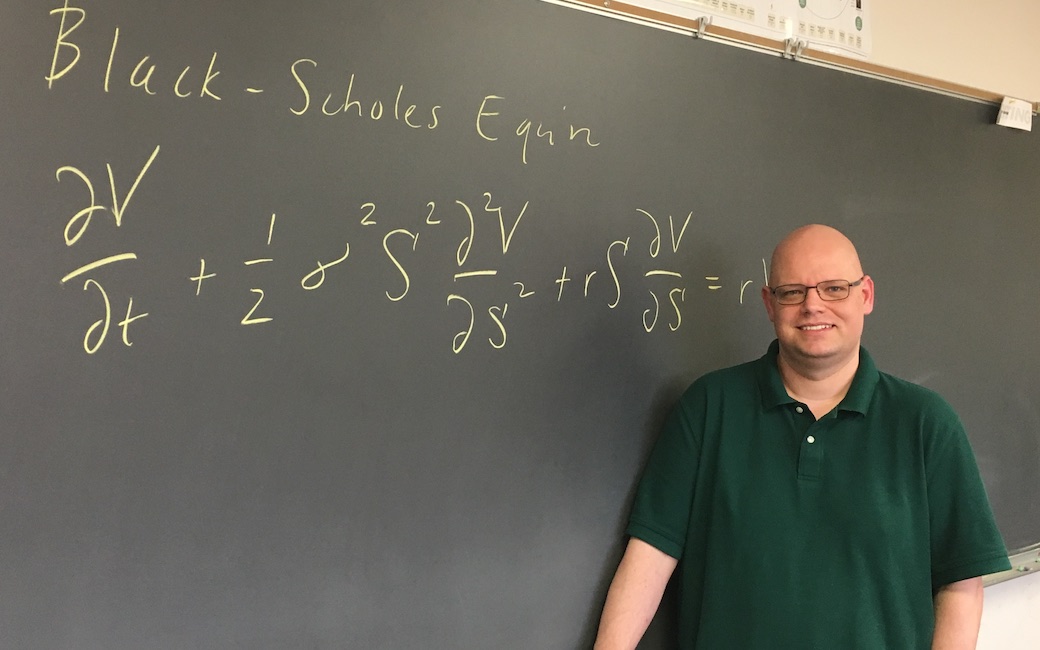Failing forward with physics
TU alum applies physics background to all areas of life
By Megan Bradshaw on July 30, 2019

Critical thinking skills and the ability to apply knowledge are two attributes Jack Mitcham ‘12 developed while earning an undergraduate degree in physics at Towson University.
These skills have served him very well since graduation.
“I like to say I learned to ‘fail forward with physics,’” he chuckles.
Mitcham addressed that very topic during his talk to Jess & Mildred Fisher College of Science and Mathematics undergraduates late in the spring 2019 term.
The CCBC-Essex graduate transferred to TU earn his bachelor’s degree and found a friendly atmosphere in the physics, astronomy and geosciences department.
“It was very welcoming and very easy to find people to help,” he says. “One thing I liked was the Society of Physics Students lounge. It’s a small program, so there’s a real camaraderie. There were a lot of like-minded people. I found my fellow nerds.”
Professor James Overduin noticed Mitcham early in his studies.
“When he called me in to talk about the midterm exam results, he asked me if I wanted to do research with him,” Mitcham says. “This was my first semester at Towson. It was very validating to be sort of handpicked by a professor for a research project.”
He completed research under the guidance of Overduin for two years, presenting some of his work at an American Physical Society (APS) meeting in Boston in 2011. Mitcham fell in love with the city’s academic atmosphere and strong nerd culture during his trip. When he was ready to choose a graduate program, he picked Northeastern University.
Mitcham failed out after one semester.
During his talk with the TU undergraduates, Mitcham stressed that while he wanted them to plan for success, he also wanted them to know their horizons are broader than they may think.
“I was laser-focused on getting a job in physics. Either you join the military and do research for DARPA, or you go into a Ph.D. program and become a professor,” Mitcham says. “Those seemed like the only options. I wanted to give the students a broader scope; that’s why I included some of the paths I didn’t know were options when I graduated.”
Mitcham fell back on his undergraduate work experience selling mattresses while he figured out his next step.
He used a Fermi problem-solving technique familiar to STEM students to decide whether to evolve his mattress sales work into a website he ran himself.
Mitcham made some estimates based on how long mattresses last, how many people buy mattresses each year, how much they pay, how frequently they used the Internet to research their choices and how likely they would be to use an external site to purchase the item.
He started Mattress Nerd while still working retail and found out he’d undercalculated profits by a factor of 10. During his best year, he made six figures and attracted the attention of Casper®. The retailer sued him, and his sales dropped 75%.
Eventually, they came to a settlement, and Mitcham sold the company.
Once again, his physics background helped him decide his next move. Mitcham enrolled in a master’s degree program in finance at UMass Boston. He discovered his ability to use equations to describe real-world implications was helpful in his new setting. Mitcham cited the helpfulness of the Black-Scholes differential equation to determine future pricing of stocks and bonds in his coursework as just one example of how he uses a physics mindset in an industry most wouldn’t connect to that field.
He completed his master’s in spring 2019 and has begun a Ph.D. program in business administration in information system for data science, also at UMass Boston. Mitcham is now the director of business intelligence at a subscription box startup.
“The ability to look at an equation and picture what that actually means—the reality behind the equation—and vice versa—how can I turn this reality into an equation—is very transferrable to a lot of different fields,” he says. “In my current position, we want to project the refund rate based on current orders, for example. Using a flat percentage didn’t work because people who use our product for different lengths of time request refunds at different rates. The refund rate was a function of several different variables, including how long a customer has been with us.
“I’m able to build a model based on that equation and calculate projections,” Mitcham continues. “That’s one example of understanding the reality of a situation and coming up with an equation. That’s not really something that’s explicitly taught; it’s implicit in every physics problem that we see.”
MORE INFORMATION
Studying physics at TU
Physics majors can choose to focus on general physics, applied physics, astrophysics, computational physics or physics secondary education.
- Learn more about the physics major.
- Request information about Towson University.